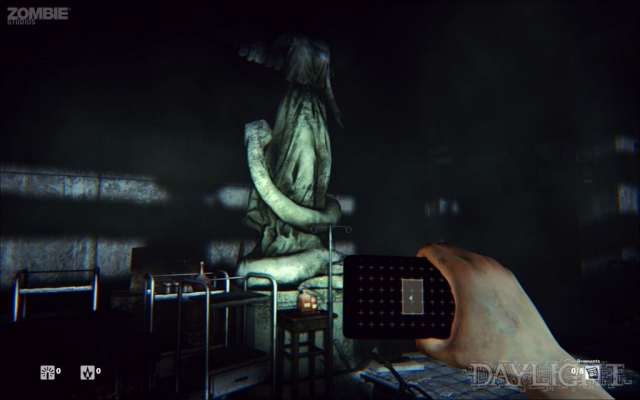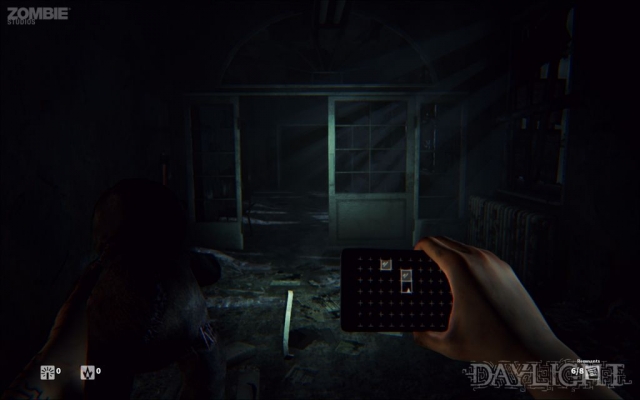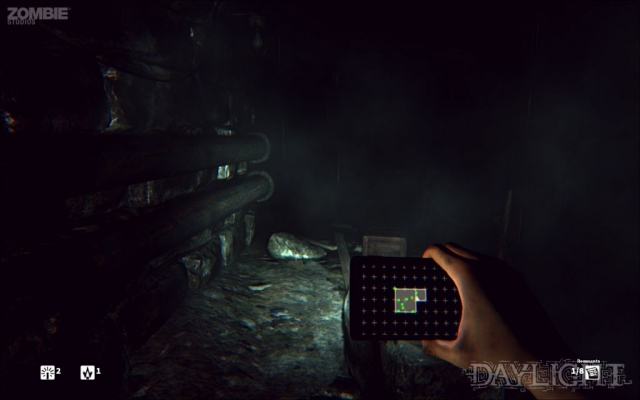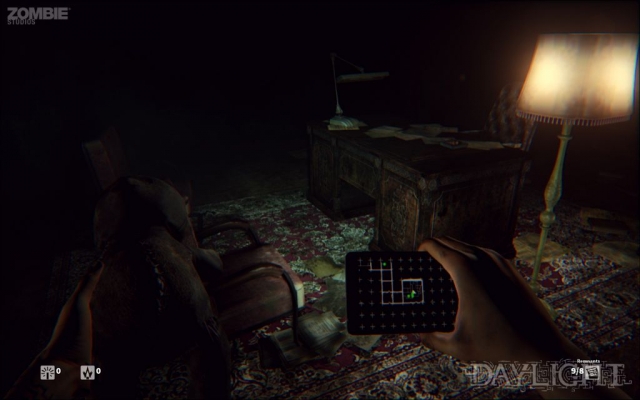Daylight
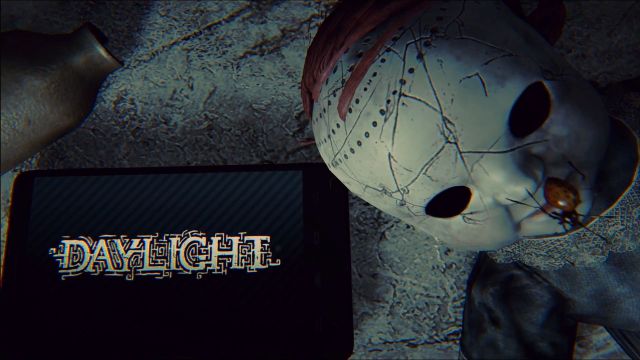
The Good: Uh. Um. It’s short.
The Bad: Awful procedural engine. Almost not a game. Terrible road flare effect.
The Ugly: I upgraded my computer for this?
I like to think of myself as a guy with a pretty extensive vocabulary, and so I took it as something of a challenge to try and come up with one single word from my considerable lexicon to describe Daylight, the new first-person horror survival game. It took me awhile, but I think I’ve got it. Are you ready? Ready? OK. Really ready? Here it is: guh. I realize that guh isn’t a word, but it so perfectly captures the awfulicity, the crapitudinalness, the hot mess that is Daylight. Incidentally, calling Daylight a first-person horror survival game is a nearly perfect misnomer, as it has almost nothing remotely scary about it, involves very little survival, and is hardly a game at all. But at least it is first-person.
Daylight begins with you awakening on the floor of an abandoned hospital (slash sanitarium, slash prison) with no memory of how you got there. All you have as a light source is your phone, which could be a pretty cool game mechanic if you had to continually worry about the battery dying and plunging you into darkness, but the whole game only takes two hours or less so it never becomes an issue. Additionally, as you begin to explore you find backpacks full of glow sticks and road flares. Really, lighting isn’t a problem. Your phone is also handy in that it keeps a map of the place as you explore (I have no idea what app does that), and occasionally you get phone calls from some guy who says very insipid things. Allow me, if you will, to expound on that.
Years ago my wife and I would throw these huge Halloween parties – a big buffet, elaborate costumes – and I would write an original mystery for the guests to play. Some of them would take roles in the mystery and they would eat and mingle and question each other, and some of the guests would get “killed,” and at the end of the night the killer would be revealed. Good fun. One year I had no time or ideas for a murder mystery, so I wrote phrases that sounded like clues but really meant nothing in the hopes that the guests would sort of organically create their own mystery. It failed miserably. On these little scraps of paper I wrote things like “The dead speak volumes. Can you understand their language?” and “This is not a clue, or is it?” The guy on the phone is just like that. He says things like “You can’t escape your fate!” and “Hell hath no fury like a woman scorned, and you have scorned them all!” Inane.
So you wander around these dilapidated, dark (but not dark) hospital corridors, getting dumb phone calls, and collecting remnants. What’s a remnant, you might ask? Good question. A remnant is a note, from either the hospital staff or sometimes a patient, tucked into a desk or hidden in a filing cabinet (or lying on the floor or tacked to the wall) which says something like “Patient 27 clawed their eyes out last night” or “The custodian says he saw something in the basement” or “This place is driving me crazy.” Sometimes they’re a faded black and white picture. Anyway, when you collect all six remnants on a given level (the last level has only five, don’t ask me why) the exit unlocks and you can proceed.
Wow, I can hear you say – this sounds like a thrill a minute. Can it possible get any more exciting? Of course it can; there are also sound effects. When I was about 7 I bought a record from the Columbia Record and Tape Club which featured a whole slew of scary sounds: moaning, wind, crickets, footsteps, banging pipes, screams. The guys who made Daylight have that record! They also have a lot of audio of a young British woman (did I mention you play as a young British woman) who screams a lot, and hyperventilates, gasps, and says things like “I can’t take any more!” and “Oh, God, make it stop!”
The game portion, such as it is, comes in when the ghosts start to appear. If they touch you, or simply get too close for too long, you die. Maybe die is the wrong word – what actually happens is you see a splash screen (Death… the Great Equalizer) and you end up back at the start of the level, losing all the remnants you had collected on the level to that point. In a way, that is a fate worse than death. The ghosts travel pretty slowly so you can often outrun them and at some point they give up chasing you. You can also light a road flare, which seems to either scare them off or temporarily destroy them; it’s not clear which. That road flare special effect though, ick. In the old Star Trek series there was an episode about a creature embodied as this little spinning ball of light which survived on hostile emotions. The flare looks exactly like that creature; this little perfectly-organized spinning ball. The epitome of 1960’s special effects. Better is the special effect for the glow stick which has a whole sequence as your character cracks the stick and then shakes it to activate the chemicals – it actually looks pretty good. The glow sticks perform the function of highlighting the locations you can search, so if you come into a room and it is empty except for a desk, and you have a glow stick lit, the desk will glow (though it indicates only that you can search it, not necessarily that something is inside it to find). So helpful! One note: the ghosts are not afraid of glow sticks.
This seems as good a time as any to write about the procedural engine, which the press release makes a big deal of. To me, a procedural engine is one in which the flow of the game is actually altered by the choices I make and the things I do. For example, by succeeding at A, B becomes easier, or if I choose to do C, D happens instead. In Daylight procedural instead seems to mean random. The corridors in the hospital all have four doors off of them (though frequently several are blocked), and it appears that the map is generated at random when the level starts. The pieces of hallway often have some kind of random event associated with it, like a fire alarm bell on the wall that rings for a moment when you enter and you (the character you) lets out a little scream. I ran into three consecutive hallway sections with the fire alarm bell gag in it, so the engine is that careless. Presumably the location of the remnants is random as well. In this way, each play through of Daylight is just the teensiest, slivery bit different. The contents of the rooms are probably random as well, and I imagine in the code that looks something like this (keeping in mind that the last code I wrote was Fortran 77 likely sometime right around 1977):
#insert Furniture;
Furniture = desk, filing cabinet, bed, cardboard box, chair;
#insert Sound Effect;
Sound effect = bump, thump, clang, moan, scream;
Besides the inside of the hospital you also get to experience the hospital sewers (where the furniture and boxes have been replaced with… furniture and boxes), and the island around the hospital (because the hospital is naturally located on an isolated island).
By the end of the game, all the remnants start to add up to a pretty thin story about an orphan and twelve witches, one of the doctors at the hospital and some cursed ground. Whatever. There are also some other minor game elements such as flipping various switches, closing valves, and dragging a very few boxes around so you can climb over things, and that’s about it. For those who are interested, I found the fastest way to get through Daylight (and believe me that you want Daylight over as quickly as possible) is to light a flare and simply run through the levels. The flares burn long enough that you can, if you’re speedy, collect all the remnants, blasting ghosts to gouts of sparks, and get to the exit on just one or two, and there are enough flares scattered about that you don’t have a serious problem running short. Using that method I cleared my second play through in just under an hour. Yay!
Guh indeed.
Reviewed By: Phil Soletsky
Publisher: Atlus
Rating: 25%
——————————————————————————–
This review is based on a digital copy of Daylight for the PC provided by Atlus.
 Game Over Online
Game Over Online